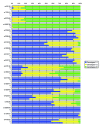Interactions between SNP alleles at multiple Loci and variation in skin pigmentation in 122 Caucasians
- PMID: 19461972
- PMCID: PMC2684124
Interactions between SNP alleles at multiple Loci and variation in skin pigmentation in 122 Caucasians
Abstract
This study was undertaken to clarify the molecular basis for human skin color variation and the environmental adaptability to ultraviolet irradiation, with the ultimate goal of predicting the impact of changes in future environments on human health risk. One hundred twenty-two Caucasians living in Toledo, Ohio participated. Back and cheek skin were assayed for melanin as a quantitative trait marker. Buccal cell samples were collected and used for DNA extraction. DNA was used for SNP genotyping using the Masscode system, which entails two-step PCR amplification and a platform chemistry which allows cleavable mass spectrometry tags. The results show gene-gene interaction between SNP alleles at multiple loci (not necessarily on the same chromosome) contributes to inter-individual skin color variation while suggesting a high probability of linkage disequilibrium. Confirmation of these findings requires further study with other ethic groups to analyze the associations between SNP alleles at multiple loci and human skin color variation. Our overarching goal is to use remote sensing data to clarify the interaction between atmospheric environments and SNP allelic frequency and investigate human adaptability to ultraviolet irradiation. Such information should greatly assist in the prediction of the health effects of future environmental changes such as ozone depletion and increased ultraviolet exposure. If such health effects are to some extent predictable, it might be possible to prepare for such changes in advance and thus reduce the extent of their impact.
Keywords: Environmental adaptability; Polygene; Single nucleotide polymorphisms (SNPs).
Figures


Similar articles
-
Interactions between SNP alleles at multiple loci contribute to skin color differences between caucasoid and mongoloid subjects.Int J Biol Sci. 2008 Mar 31;4(2):81-6. doi: 10.7150/ijbs.4.81. Int J Biol Sci. 2008. PMID: 18392143 Free PMC article.
-
Evaluation of linkage disequilibrium measures between multi-allelic markers as predictors of linkage disequilibrium between single nucleotide polymorphisms.Genet Res. 2007 Feb;89(1):1-6. doi: 10.1017/S0016672307008634. Genet Res. 2007. PMID: 17517154
-
High-throughput SNP genotyping with the Masscode system.Mol Diagn. 2000 Dec;5(4):329-40. doi: 10.1007/BF03262094. Mol Diagn. 2000. PMID: 11172497 Review.
-
A compilation of tri-allelic SNPs from 1000 Genomes and use of the most polymorphic loci for a large-scale human identification panel.Forensic Sci Int Genet. 2020 May;46:102232. doi: 10.1016/j.fsigen.2020.102232. Epub 2020 Jan 17. Forensic Sci Int Genet. 2020. PMID: 31986343
-
Hypertension genetics, single nucleotide polymorphisms, and the common disease:common variant hypothesis.Hypertension. 2002 Feb;39(2 Pt 2):323-31. doi: 10.1161/hy0202.104087. Hypertension. 2002. PMID: 11882567 Review.
Cited by
-
Interactions between SNP alleles at multiple loci contribute to skin color differences between caucasoid and mongoloid subjects.Int J Biol Sci. 2008 Mar 31;4(2):81-6. doi: 10.7150/ijbs.4.81. Int J Biol Sci. 2008. PMID: 18392143 Free PMC article.
-
Melanocortin-1 receptor, skin cancer and phenotypic characteristics (M-SKIP) project: study design and methods for pooling results of genetic epidemiological studies.BMC Med Res Methodol. 2012 Aug 3;12:116. doi: 10.1186/1471-2288-12-116. BMC Med Res Methodol. 2012. PMID: 22862891 Free PMC article.
References
-
- Aoki K. Sexual selection as a cause of human skin color variation: Darwin's hypothesis revisited. Ann. Hum. Biol. 2002;29(6):589–608. - PubMed
-
- Akey JM, Wang H, Xiong M, et al. Interaction between the melanocortin-1 receptor and P genes contributes to inter-individual variation in skin pigmentation phenotypes in a Tibetan population. Hum. Genet. 2001;108(6):516–520. - PubMed
-
- Anno S, Abe T, Sairyo K, et al. Interaction with SNP allele in multiple loci contributes to human skin color diversity (1) Journal of Physiological Anthropology. 2006;11(1):30–31.
-
- Flanagan N, Healy E, Ray A, et al. Pleiotropic effects of the melanocortin 1 receptor (MC1R) gene on human pigmentation. Hum. Mol. Genet. 2000;9(17):2531–2537. - PubMed
-
- John PR, Makova K, Li WH, et al. DNA polymorphism and selection at the melanocortin-1 receptor gene in normally pigmented southern African individuals. Ann. N.Y. Acad. Sci. 2003;994:299–306. - PubMed
LinkOut - more resources
Full Text Sources
